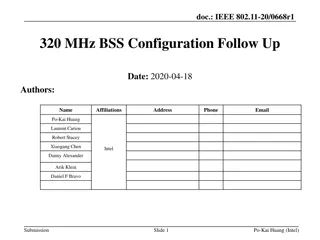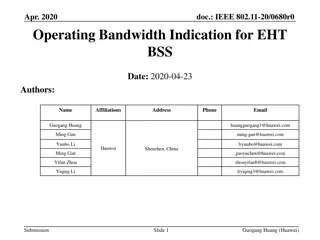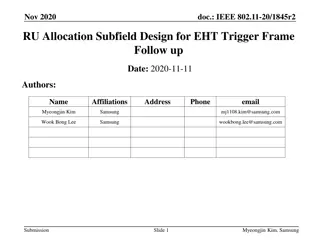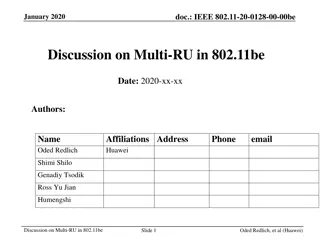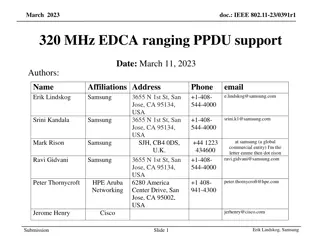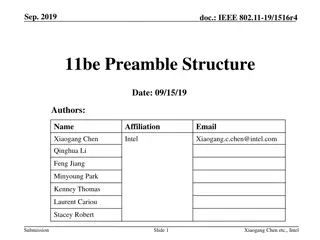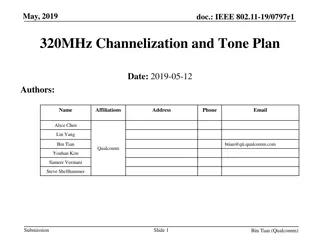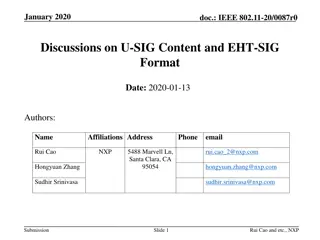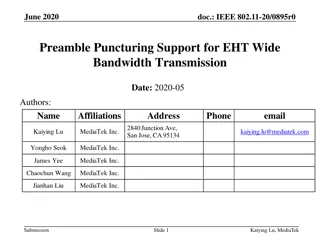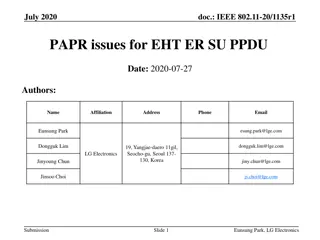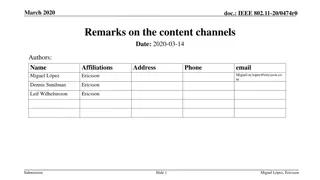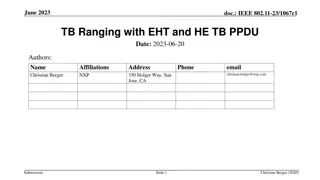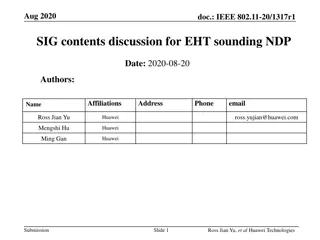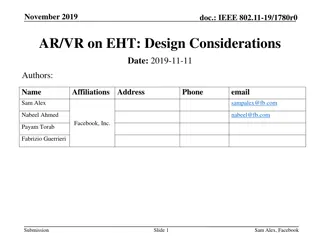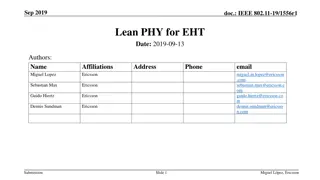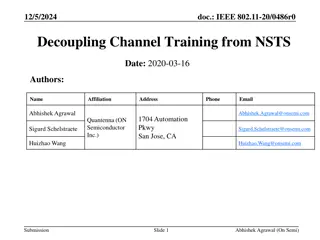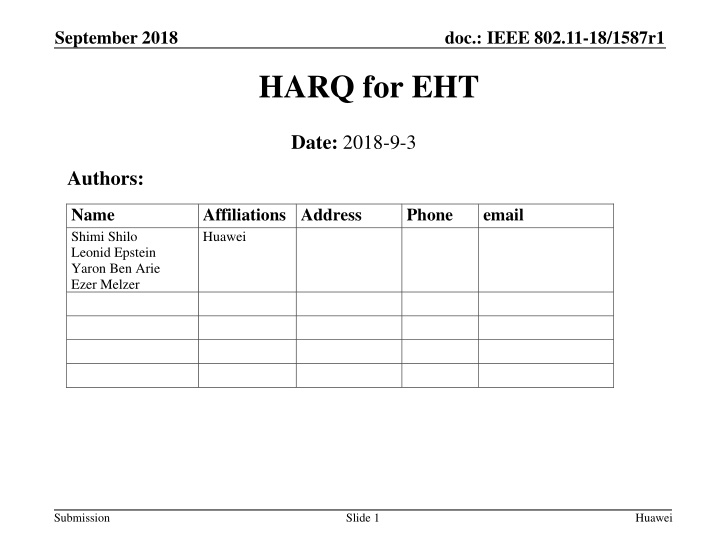
IEEE 802.11-18/1587r1 HARQ Mechanism for Enhanced Wi-Fi Technology
Explore the implementation of Hybrid Automatic Repeat Request (HARQ) in IEEE 802.11 standards to enhance wireless link quality and performance. Learn about HARQ operation, benefits, and integration into 802.11 protocols, aiming to improve data transmission reliability and efficiency for next-generation Wi-Fi technologies.
Download Presentation

Please find below an Image/Link to download the presentation.
The content on the website is provided AS IS for your information and personal use only. It may not be sold, licensed, or shared on other websites without obtaining consent from the author. If you encounter any issues during the download, it is possible that the publisher has removed the file from their server.
You are allowed to download the files provided on this website for personal or commercial use, subject to the condition that they are used lawfully. All files are the property of their respective owners.
The content on the website is provided AS IS for your information and personal use only. It may not be sold, licensed, or shared on other websites without obtaining consent from the author.
E N D
Presentation Transcript
September 2018 doc.: IEEE 802.11-18/1587r1 HARQ for EHT Date: 2018-9-3 Authors: Name Shimi Shilo Leonid Epstein Yaron Ben Arie Ezer Melzer Affiliations Address Huawei Phone email Submission Slide 1 Huawei
September 2018 doc.: IEEE 802.11-18/1587r1 Background Hybrid Automatic Repeat Request (HARQ) is a mechanism widely used in wireless/cellular technologies to improve link quality In this presentation, we describe the existing retransmission operation in 802.11a/g/n/ac/ax We then discuss HARQ operation, its main benefits, respective complexity and the applicability to the EHT standard Our aim is to integrate HARQ into 802.11 while making as few changes to the existing protocols as possible Submission Slide 2 Huawei
September 2018 doc.: IEEE 802.11-18/1587r1 Retransmissions in 802.11 The following protocol is used in 802.11a/g/n/ac/ax: The transmitter sends an (A-)MPDU Each MPDU contains a checksum which the receiver can use to verify it was decoded without errors The receiver responds with an ACK/Block-ACK, indicating which MPDU was decoded correctly Incorrectly decoded MPDUs are retransmitted; these can be aggregated with new MPDUs SIFS SIFS backoff A-MPDU A-MPDU Failed Block ACK MPDU #2 MPDU #4 MPDU #1 MPDU #2 MPDU #3 Block ACK Time Submission Slide 3 Huawei
September 2018 doc.: IEEE 802.11-18/1587r1 HARQ HARQ is a mechanism in which soft-bits (LLRs) respective to past and current transmissions are combined in order to increase the probability of correct decoding Similar to MRC, yields combining and potentially diversity gain The receiver stores LLRs of incorrectly decoded transmissions, indicates to the transmitter which transmissions failed, and the transmitter responds by retransmission Submission Slide 4 Huawei
September 2018 doc.: IEEE 802.11-18/1587r1 HARQ - Benefits There are several benefits associated with HARQ: Improved link performance due to combining several retransmissions Link range extension (improved coverage), particularly at the low SNR region Offers effectively an extended set of MCSs, with finer granularity, thus making link adaptation (a weak point in 802.11) more robust and efficient higher dataput Performance gain across the board, in every scenario/configuration (irrespective of BW, MIMO mode, etc.) Submission Slide 5 Huawei
September 2018 doc.: IEEE 802.11-18/1587r1 HARQ - Benefits In the following figure, we compare between MCS 1 and MCS 2 with 1500B payload over a 242-tone RU and assuming SISO, in TGn-D NLOS, for two cases: Without HARQ: single transmission (no combining) With HARQ: combining two transmissions HARQ yields a significant benefit of ~4dB as expected The channel between the 1st Tx and Re-Tx is highly correlated Submission Slide 6 Huawei
September 2018 doc.: IEEE 802.11-18/1587r1 HARQ - Benefits Based on the figure in the previous slide, we compute the data rate respective to the following two cases (SNR is 10dB): MCS 1, w/o HARQ, operating @PER=4% MCS 2, with HARQ, operating @PER=30% The figure on the right shows the data rate as a function of the MPDU size within the A-MPDU (containing 64 MPDUs) As seen, HARQ yields ~20% throughput gain irrespective of the MPDU size Submission Slide 7 Huawei
September 2018 doc.: IEEE 802.11-18/1587r1 HARQ - Benefits We want to look at the impact of HARQ over the entire range of practical SNR values We begin by looking at the achievable throughput where the best MCS is chosen at each SNR, without HARQ Results are shown on the right; we assume a SISO configuration over a TGn-D NLOS channel Submission Slide 8 Huawei
September 2018 doc.: IEEE 802.11-18/1587r1 HARQ - Benefits The throughput for the same configuration is computed when HARQ is used, where the computation takes into account all durations (including backoff, preamble+payload, SIFS, Block- ACK, retransmission) As shown, HARQ yields benefits across the entire SNR range 10-30% throughput improvement Improved throughput and coverage The HARQ throughput result is much smoother which effectively means finer MCS granularity ~10% throughput improvement Submission Slide 9 Huawei
September 2018 doc.: IEEE 802.11-18/1587r1 HARQ - Benefits Furthermore, we may try to incorporate slightly more advanced HARQ schemes, such as Incremental Redundancy (IR), to yield even better results In the figure on the right, we added the throughput respective to IR HARQ As shown, there is a significant throughput enhancement, especially in the high SNR regime Submission Slide 10 Huawei
September 2018 doc.: IEEE 802.11-18/1587r1 HARQ Complexity Aspects In order to combine previous and current LLRs, the receiver must store these LLRs in memory The more memory is allocated for HARQ, the higher the number of incorrectly decoded MPDUs that can be stored and combined with future retransmissions This, however, increases the area & cost, so we want to analyze how much memory is really required Submission Slide 11 Huawei
September 2018 doc.: IEEE 802.11-18/1587r1 HARQ Complexity Aspects Let s see how many LDPC codewords fail within a failed MPDU We assume a 1500-Byte MPDU, transmitted at rate which means 13 LDPC codewords, each 1944 bits; the data is transmitted over a TGn-D NLOS channel The figure on the right shows the distribution of number of failed codewords The average number of failed codewords is ~6 for 10/20/30% PER This means that ~6 out of 13 LDPC codewords have to be stored, on average half! It also means the receiver doesn t need to process all LDPC codewords for failed MPDUs, reducing processing time and improving probability of correct decoding. Submission Slide 12 Huawei
September 2018 doc.: IEEE 802.11-18/1587r1 HARQ Complexity Aspects Let s analyze how much memory is required for typical HARQ operation in 802.11 Consider the following assumptions: A-MPDU contains 16 MPDUs, each of size 1500B Each MPDU contains 13 LDPC codewords of size 1944 bits (coding rate = 1/2) 1 Byte per LLR Operating at 30% PER At every transmission, 0.3*16~=5 MPDUs fail, which means LLRs for 5*6=30 LDPC codewords have to be stored This means 30*1944=58KB are required to store the LLRs of 5 MPDUs No additional memories required at transmitter side Considering density of existing memories, this is not a major issue Submission Slide 13 Huawei
September 2018 doc.: IEEE 802.11-18/1587r1 HARQ in EHT HARQ is a well known method, used in other technologies (e.g. LTE in licensed and unlicensed bands), where it yields performance improvements HARQ can significantly improve the performance of 802.11, as shown in the previous slides The additional design complexity and HARQ related memory size are not significant Since link adaptation is a (relatively) weak point of 802.11, incorporating HARQ will enable a decrease in the fade margin and operation at higher MCS values Submission Slide 14 Huawei
September 2018 doc.: IEEE 802.11-18/1587r1 Summary HARQ is a proven technology, used in other wireless standards also in the unlicensed bands (which are used for 802.11) HARQ can be used in any scenario/configuration regardless of the number of Tx or Rx antennas, MIMO mode, BW etc. The performance improvements associated with HARQ can be used to significantly enhance the link adaptation mechanism in 802.11 We think that HARQ should be incorporated into the 802.11 protocol and become a part of the upcoming EHT standard Submission Slide 15 Huawei

